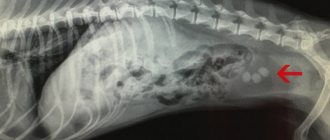- October 6, 2018
- Prostatitis
- Tatyana Andreeva
Dogs aged five years and older quite often suffer from inflammation of the prostate gland. Prostatitis in dogs is a serious disease that requires timely treatment. Symptoms of the pathology are often confused with cystitis, so only a veterinarian can make an accurate diagnosis and prescribe treatment. In this article we will take a closer look at the causes and methods of treating this insidious disease.
What it is
The prostate gland in dogs is an important organ. It is located in the area of the bladder neck and urogenital canal and plays an important role:
- produces ejaculate;
- blocks the opening of the bladder during ejaculation.
The organ has a lobed structure and a round shape. The animal’s body constantly produces ejaculate, which is excreted not only during the ejaculation process, but also with the animal’s urine.
Most often, prostatitis in dogs is of bacterial origin and is the result of inflammation in the prostate gland, urethra or bladder. These are the most common cases and occur more often than others. But sometimes the illness is a consequence of more serious diseases. One of these may be pyelonephritis.
In more than 80% of cases, prostatitis develops in uncastrated dogs aged 7-8 years. The older the animal, the higher the risk of pathology. The disease can be acute or chronic. The first form is more dangerous, as it often leads to complications such as abscess and purulent peritonitis.
Anatomical features of the prostate in dogs
The prostate gland is located at the base of the bladder neck, where the urethra becomes the genitourinary canal.
In young dogs, those who are not yet 3 years old, the entire complex of organs is located in the pelvic region, but over the years it gradually shifts to the abdominal area.
Functions and norms
The prostate gland produces a secretion that dilutes the “porridge” of sperm and, as it were, “starts” them, transfers them to an active state, making them mobile. The gland has many excretory ducts, through which secretions are discharged into the lumen of the genitourinary canal.
Normally, the secretion of the gland is capable of suppressing the activity of pathogenic microflora, but with age and due to some other factors (overheating, hypothermia, stress), the antibacterial properties of the secretion decrease and the microflora begins to develop, leading to destructive changes.
Possible pathologies
With pathological phenomena in the prostate gland, the symptoms are very often identical, but the processes are different, therefore, the diagnosis and treatment methods will differ.
The most common diseases in dogs are:
- prostatitis;
- hyperplasia (benign);
- cystosis
- Tumors and abscesses are less commonly diagnosed.
Causes
There are many known causes that can cause prostatitis in dogs. Most often these are inflammatory processes in organs that are located in close proximity to the prostate gland, or hormonal imbalances.
Causes of prostatitis also include:
- treatment with hormonal drugs;
- the presence of diseases such as colitis, proctitis and urethritis;
- the presence of various infections in the body;
- incorrectly selected treatment for other pathologies;
- penile injuries;
- inactive lifestyle of the animal;
- poor penile hygiene;
- decreased immunity;
- genetic predisposition.
A consequence of prostatitis in dogs can be considered an enlarged prostate gland. When an organ becomes much larger than normal, blood flow in its tissues slows down, and this serves as a favorable environment for the development of microbes.
Are you here
Definitions, reasons
Prostatic and paraprostatic cysts are nonseptic, fluid-filled cavities lined with epithelium within the prostate or attached to it.
Parenchymal or prostatic cysts usually develop in the prostate parenchyma during benign hyperplasia; paraprostatic cysts are adjacent to the prostate and can be connected to it by ducts or attached by a stalk (not always determined). Prostatic or parenchymal cysts usually connect to the urethra; paraprostatic cysts do not connect to the urethra. Cysts in dogs vary greatly in number and size. Prostatic and paraprostatic cysts are quite rare in dogs, and the exact cause of their development has not been determined, with only a few theories proposed. One theory suggests progressive secretory stasis due to ductal obstruction secondary to estrogen-induced squamous metaplasia of the prostate. Based on this theory, multiple cavities are formed in the prostate parenchyma extending into the abdominal cavity or pelvic canal. The second theory puts forward the formation of a prostate hematoma as the cause of the formation of cysts; in its last stage, mineralization of the fibrous wall of the cavity occurs. The third theory of cyst formation involves the accumulation of fluid in the remains of the male uterus (Müllerian duct).
Clinical signs
Intact male dogs of large breeds of advanced age are predisposed to the disease; dogs are often asymptomatic until the development of cysts leads to compression of neighboring organs - the large intestine, bladder and urethra. The main reasons for visiting a veterinary clinic are difficulties with urination, tenesmus, constipation and bloody discharge from the urethra. Also, in dogs with prostatic and paraprostatic cysts, general depression and decreased appetite may be observed; these signs develop due to infection of the cysts. A rectal examination reveals changes in the shape and size of the prostate. With a significant volume of cysts, they can be palpated through the abdominal wall, most of them develop on the craniolateral side of the prostate.
Plain radiographic examination reveals structures similar to the bladder; contrast cystourethrography can be used to differentiate them. The wall of the cysts, together with the prostate, is subject to mineralization in up to half of the cases, which is clearly visible on x-rays. Ultrasound examination reveals cavitary changes well; parenchymal cysts usually appear as anechoic cavities with more regular edges than with an abscess, but cytological examination is necessary to accurately distinguish between a cyst and an abscess. Paraprostatic cysts on ultrasound usually appear as large anechoic formations with an internal membrane, some of which are connected to the prostate parenchyma. A definitive diagnosis can be obtained by ultrasound-guided fine-needle biopsy, but care must be taken to avoid iatrogenic infection of the peritoneal cavity due to an abscess.
Diagnosis and differential diagnosis
A presumptive diagnosis is based on characteristic clinical features, and surgical drainage of the cyst and excisional biopsy may be required to make a definitive diagnosis. The list of differential diagnoses includes diseases such as prostate abscess, squamous metaplasia of the prostate, prostatic hyperplasia and prostatic neoplasia.
Treatment, prognosis
Treatment of small parenchymal cysts is carried out through castration; in dogs with large prostate cysts, castration is combined with complete excision of the cysts; if complete excision is not possible, partial excision is performed, followed by drainage, marsupalization or omentalization of the cavities. An alternative to surgical treatment is ultrasound-guided percutaneous drainage.
Valery Shubin, veterinarian, Balakovo
Source balakovo-vet.ru
Prostate cysts are:
Cell changes caused by hormonal instability.
Retention cysts inside the prostate that can form cavities in the tissue or organ.
Liquid-filled capsules (sac-like structures).
Paraprostatic (located near the prostate) cavities filled with fluid.
Prostate cysts can range in diameter from a few millimeters to 20 cm. Paraprostatic cysts usually form on and along the top of the prostate, displacing the bladder, or at the back of the prostate, in the renal pelvis. These types of cysts affect reproductive males between the ages of 2 and 12 years. Large dogs are more at risk than small dogs.
Acute symptoms
Before examining the question of how to treat prostatitis in dogs, it is necessary to understand the symptoms of the disease. They may vary depending on the form of the course: chronic or acute.
During the acute form, a sharp change in the animal’s condition for the worse occurs, during which the following signs are observed:
- At the initial stage of development of pathology, the animal can lead a normal lifestyle and not show signs of illness. But an attentive owner will still notice such a dangerous symptom as hematuria - blood in the urine. In addition, the dog may experience mucous discharge from the urethra.
- Another warning sign for the owner may be the dog’s anxiety during bowel movements, which indicates painful sensations. In this case, the feces themselves will have a ribbon-like shape.
- With acute prostatitis in a dog, especially if there is an abscess, the pain can be so severe that it will be visible in the gait.
- On palpation, pain and swelling are felt.
- In addition, the acute form is characterized by high fever, depression and vomiting.
With such signs, the animal must be immediately shown to a specialist to prescribe a course of treatment and alleviate the animal’s condition.
Course of the disease and symptoms
Prostatitis in a male dog can be either acute or chronic. In the acute form, the disease manifests itself with the following symptoms:
- high temperature (up to +40 degrees);
- headache;
- nausea, vomiting;
- difficulty with bowel movements;
- loss of appetite;
- frequent urination with blood;
- difficulty urinating;
- severe pain;
- stiffness of the dog’s gait;
The animal may experience feverish conditions: permanent or temporary. The gait takes on “wooden” characteristics and the dog becomes inactive. Possibly indigestion in the form of constipation and diarrhea. A pet may lose a lot of weight during its illness. Sometimes the dog spends hours trying to perform the act of urination, but to no avail.
In addition to the above, a dog infected with this disease is likely to become infertile. That is, such a male cannot be used for breeding.
If you notice the listed symptoms in your dog, you need to take your pet to a veterinarian. The sooner the diagnosis is made and treatment begins, the more likely it will be to prevent possible complications of prostatitis. Note that although the acute form can be treated more quickly, it often leads to complications in the form of dangerous abscesses or even purulent peritonitis.
The chronic course of the disease does not have such pronounced symptoms. Most often, with a similar course of the disease, the dog periodically feels pain when urinating, but outwardly this fact does not manifest itself in any way and is invisible to the owner of the animal. In general, the dog’s condition is normal - the animal eats as usual, is quite active and cheerful. This lack of symptoms makes early detection of chronic prostatitis very difficult, which sometimes leads to serious consequences.
Chronic prostatitis in a dog can only be detected by examination by a veterinarian. Therefore, every pet owner should make it a habit to regularly examine their pet at the veterinary clinic, regardless of whether there are any alarming symptoms or not.
Chronic form
Chronic prostatitis is a consequence of improper treatment of the acute form of the disease, symptoms of inflammation are weak or absent at all, the general condition of the dog is normal, but the destructive process in the tissues progresses.
The chronic course of the disease is characterized by frequent alternation of periods of remission and exacerbation; the older the dog, the shorter the periods of calm.
The form of the disease is chronic, description of symptoms
In this form, the signs are not so pronounced, and sometimes are absent altogether. During illness, you can observe a difficult process of urination in a dog, which is accompanied by painful sensations.
In addition to these symptoms, it is quite difficult to determine the disease with prostatitis, therefore, in order to detect it, it is necessary to regularly bring your pet for examination to a veterinarian. This is the only way to detect the disease and take the necessary measures.
Paraprostatic cysts
Another common disease of the prostate gland in male dogs is paraprostatic cysts - this is the process of formation of cystic structures outside the prostate gland. The reasons for the formation of such cysts in the prostate in male dogs are not clear, but they are often a consequence of acute prostatitis.
Symptoms of paraprostatic cysts in dogs. Reaching large sizes, cysts often compress neighboring organs, leading to impaired urination and defecation. Often they can be palpated (felt) through the abdominal wall. These formations are often confused with the bladder, and with a long process, calcium salts begin to be deposited in the wall of the cyst, leading to calcification. For diagnosis, an ultrasound scan of the prostate is performed, but it is necessary to catheterize the bladder to avoid misdiagnosis.
Treatment of paraprostatic cysts in dogs is surgical. During the operation, it is necessary to completely remove the wall of the formation or, if this procedure is impossible, to perform marsupialization of the cyst - the process of opening the cyst, washing and suturing its edges to the skin of the abdominal wall. Over time, this cyst will completely atrophy and will not cause any problems to the dog.
Prostate tumor in dogs
The most dangerous prostate disease is prostate tumor in dogs. Benign prostate tumors in male dogs are, unfortunately, rare. The most common type of prostate cancer is adenocarcinoma, a malignant tumor of the glandular tissue. According to a number of authors, 80% of dogs affected by prostate adenocarcinoma already have distant metastases at the time of diagnosis. The most typical method of metastasis for prostate cancer in males is the lymphogenous route to the iliac lymph nodes and the hematogenous route, affecting the lungs and skeletal bones.
Symptoms of prostate tumors in dogs vary. They include weight loss, pain in the perineum, difficulty urinating and defecating, and blood in the urine. To diagnose this disease, an ultrasound of the prostate is performed, which shows an increase and abnormal deformation of the organ, which should serve as a signal for a biopsy.
Treatment of prostate adenocarcinoma is difficult due to the low possibility of complete tumor removal due to the anatomical features of the prostate gland. In the early stages, a total prostatectomy is indicated - complete removal of the prostate gland in dogs with reconstruction of the urethra. In the future, chemotherapy is indicated - the introduction of toxic drugs that kill tumor cells.
Chronic form
Sometimes the dangerous symptoms of prostatitis in dogs disappear, and the dog calms down, and so does his owner. However, this does not mean that the disease has receded. In this case, it passes into a chronic form, in which mild discomfort or no symptoms can be observed. During this period, tissue inflammation slowly progresses.
In the chronic form of prostatitis, the animal does not experience painful sensations, but still the process often turns into an acute form, and then a period of relief begins again.
The danger of this stage of the disease is that it is difficult to identify in the early stages in order to provide timely treatment. Prostatitis in dogs is diagnosed only during an examination by a doctor, which is why it is so important to take your animal for preventive examinations once every six months.
Clinical manifestations
Pathology develops and occurs in two forms:
- Spicy.
- Chronic.
Prostatitis in dogs and its pathological symptoms are determined by its form. First of all, prostatitis is manifested by dysfunction of urination. The pet goes to the toilet more often, but at the same time urinates in small portions. The pathology can also manifest itself as urinary incontinence; urine leakage is observed even when the dog is at rest. Urinary retention is a symptom that develops due to prostate enlargement.
In the acute phase the following are observed:
- increased body temperature;
- pain while walking;
- headache;
- nausea and vomiting;
- the urge to urinate and tenesmus become more frequent, accompanied by acute pain in the abdominal area;
- pain in the lower back spreading to the pelvic area;
- general weakness;
- swelling of the limbs.
The symptoms of prostatitis in chronic form are not so pronounced:
- the pain is mild, as a rule, manifests itself only in the form of slight discomfort;
- urination is difficult.
Sexual dysfunction and infertility develop.
If you notice the most minor symptoms, it is important to immediately contact a veterinarian. The pet needs careful diagnosis and effective therapy. Remember that an untimely visit to the veterinarian can cost the dog’s life, because the main danger of prostatitis is its complications.
Diagnostics
To make an accurate diagnosis, a specialist must exclude the presence of other diseases: tumors, cystitis, and so on. Methods for diagnosing prostatitis include:
- palpation of the gland;
- Ultrasound;
- urine and blood tests;
- the presence of characteristic symptoms;
- rectal examination of the gland.
After diagnostic tests, a qualified veterinarian will give the necessary recommendations and prescribe therapy, which in most cases can be carried out at home. Prostatitis in dogs can be treated for a long time, but with a well-chosen course it is very successful.
Diagnostic methods
It is impossible to independently diagnose prostatitis in dogs without appropriate education. Therefore, if you have symptoms indicating a possible disease, you should contact a veterinary clinic, where a diagnosis will be made based on a rectal examination and laboratory tests.
Diagnosis of prostatitis consists of a comprehensive study of physiological indicators and is not limited to laboratory tests.
Main types of research:
- general urine analysis;
- examination of urethral swabs;
- antibiogram;
- biochemical and clinical blood tests;
- Ultrasound examination of the genitourinary system.
History taking
It is necessary to collect a complete history, take into account the main complaint and the general condition of the patient. Pay attention to the state of urination and defecation.
Urinalysis and bacteriological culture
Detection of hematuria, bacteriuria/pyuria in the urine analysis of an uncastrated male dog can always indicate the possibility of prostate diseases.
If an infectious process in the prostate is suspected, it is recommended to take sperm or urine for bacteriological examination. In this case, urine can be taken for bacteriological culture in several ways:
1) By cystocentesis (the gold standard for culture testing for urinary tract infections), but it should be taken into account that urine culture may be falsely negative if the prostatic secretion has not contaminated the contents of the bladder.
2) By taking a mid-portion of urine (in this case, possible contamination of pathogenic microflora from the distal part of the urethra should be taken into account).
Blood tests
Blood tests are necessary to exclude systemic diseases and screen for hidden diseases in aging animals.
Serological tests designed specifically for the diagnosis of prostate diseases are currently not available.
Cytological examination of any urethral discharge
Discharge from the urethra
If prostate disease is suspected, it is necessary to examine the secretion of the gland in a male dog in order to determine the cause of the pathological process.
Any discharge from the urethra should be examined microscopically.
Bacteriological culture of the urethra should not be performed due to the presence of bacterial flora in the distal part of the urethra.
Sperogram
In males, sperm consists of 3 fractions
- Urethral
- Spermatic
- Prostatic.
For diagnostic purposes, 2-3 ml of the third fraction is collected. For the accuracy of the result, cytological and cultural examination is required, since bacterial flora is normally present in the distal part of the urethra.
With diseases of the testes and appendages, the appearance and color of the ejaculate may change.
The prostatic secretion of a healthy dog contains a small amount of leukocytes, epithelial cells, and bacteria. Sperm pH 6.0-6.7.
Deviations during the study:
- a large number of leukocytes.
- a large number of red blood cells
- bacteria in large numbers located inside leukocytes and macrophages.
-macrophages containing hemosiderin.
When culturing the ejaculate, a large number of gram-negative microorganisms in combination with a large number of leukocytes indicates an infectious process, unless the sample was contaminated with preputial contents during collection.
In cases of suspected prostate neoplasm involving the prostatic urethra, the likelihood of the presence of atypical cells in samples obtained from prostate massage is greater compared with the likelihood of their presence in the ejaculate.
Urethroscopy
The prostatic urethra can be visualized using urethroscopy. In this case, it is possible to visualize the flow of exudate or bleeding into the prostatic part of the urethra and exclude non-prostate urethral lesions as the cause of urethral discharge.
Prostate biopsy
Under ultrasound control, a needle aspiration biopsy (14-18 G biopsy needles) is performed from intraprostatic cavity lesions to collect cellular material for cytological examination. When receiving an aspiration biopsy, the prostatic fluid should be examined microscopically, as well as bacteriological culture to detect pathogenic microflora.
The most common complication of prostate biopsy is mild hematuria, but significant bleeding is also possible. To avoid complications, before performing a biopsy, it is recommended to take a test to study the patient’s blood clotting - a coagulogram.
1. Percutaneous biopsy. Conducted via transabdominal access under ultrasound guidance, the animal is under sedation.
2. Surgical biopsy. X surgical biopsy is performed using a biopsy needle by wedge-shaped resection of the parenchyma. Before performing a biopsy, cysts or areas of potential abscess should be aspirated. A sample of sublumbar lymph nodes should also be taken.
Ultrasonography
Ultrasound diagnostics is the best method for assessing the prostate gland. In this case, it is possible to determine the size and homogeneity of the prostate tissue.
The prostate parenchyma is homogeneous, of medium echogenicity with fine or medium granularity and smooth edges. In the sagittal projection, the shape of the organ is round or oval; in the transverse projection, it is estimated that both lobes are symmetrical.
The prostatic part of the urethra with its surrounding muscles and vertical suture is visualized as a hypoechoic structure located between the two lobes. Ultrasound diagnostics can determine the presence of inflammation of the prostate, abscess, prostate cysts, and prostate tumors.
It is necessary to examine the sublumbar lymph nodes. During infectious processes or neoplasms, their increase or change in echogenicity may be observed.
Radiography
X-rays provide information about the size and location of the prostate gland. The photographs can reveal its increase. However, radiography is of limited benefit. In many cases, palpation of the prostate can provide more accurate results.
For dysuria in dogs, the test of choice for prostate disease is remote retrograde urethrocystography.
With asymmetry of the prostate in relation to the urethra, narrowing of the prostatic part of the urethra, the following are most likely: abscess formation, parenchymal cysts, neoplasms, hyperplasia. If the X-ray shows marked enlargement of the prostate, presumably due to a neoplasm, radiographs of the chest and abdomen should be examined for signs of metastasis.
Physical examination (prostate palpation)
It is advisable to use the two-handed method. The prostate gland is palpated with a finger through the rectum, in the ventral part of the pelvic canal. During palpation, it is necessary to evaluate the size, consistency, symmetry, contours, whether it is fixed or removable. Physical examination of the prostate gland through the rectum can be facilitated by simultaneous palpation of the caudal part of the abdominal cavity, pressing on which can displace the gland more caudally along the pelvic canal. Normally, a healthy gland is smooth, symmetrical, and painless.
Therapy
The following drugs are used in the treatment of prostatitis:
- To relieve the inflammatory process, antibiotics are prescribed, but in order for such therapy to be successful, it is necessary to conduct a sensitivity study to different types of antibiotics. To do this, swabs are taken from the urethra and sent to the laboratory.
- The specialist can prescribe broad-spectrum drugs that are typical for the prostate microflora. But it is worth considering this fact: not every antibiotic is able to penetrate the epithelium of the gland; it must have a high acidity constant and be slightly alkaline.
- Macrolides are considered the least toxic drugs. They remain in the tissues of the gland for a long time and maintain antibacterial conditions. An example of such a medicine would be Azithromycin.
- Experienced veterinarians often resort to fluoroquinolones. These are modern drugs that have a pronounced antibacterial effect. The drug leaves the body unchanged along with urine, and due to its high concentration it gives a positive effect. One such remedy is Profloxacin. For an animal up to ten kilograms, 1/4 tablet twice a day is enough.
- Such drugs as Marbofloxacin, Enrofloxacin, Trimetaprim and Clindamycin have proven themselves to be effective. The course of treatment with these drugs lasts from four to five weeks, depending on the form of the disease.
- For prostatitis against the background of hyperplasia, complex therapy using antiandrogen drugs is used.
- For older dogs, experts prescribe a chidectomy.
- Often, with a complex course of the disease, surgical treatment of prostatitis in dogs is prescribed. This therapy means castration of the animal. If the dog is young and this method is unacceptable, you can use progestogen agents. These include: medroxyprogesterone acetate, megestrol acetate and chlormadinone acetate.
Advice for dog owners - Prostate diseases in male dogs
Dear dog owners!
According to statistics, 60% of uncastrated males over 5 years old and 100% of uncastrated males older than 10-12 years have prostate hyperplasia. Timely castration of male dogs not used for reproduction prevents age-related prostate hypertrophy. Among the diseases of the prostate gland there are: - acute and chronic prostatitis - benign prostatic hyperplasia - squamous metaplasia of the prostate - prostate abscess - prostate cysts - neoplasia. The main clinical symptoms of prostate diseases: - urinary disorders: increased frequency of urination, urination in small portions, drops, urinary incontinence, blood in the urine (not only during urination, but also during periods of rest), recurrent urinary tract infections, urinary retention up to until complete obstruction; - systemic symptoms: chronic hyperthermia (increased body temperature), periods of acute fever, collapse, shock in the terminal stage of the disease; - motor dysfunction: deep pain and discomfort in the pelvic area, pain in the lower spine, weakness or paresis of the pelvic limbs, pain in long bones with metastases, septic arthritis, swelling of the pelvic limbs; - gastrointestinal symptoms (not always observed, but sometimes are the only symptoms): frequent urge to defecate (tenesmus), constipation, thin ribbon-like feces, one- or two-sided rectal diverticulum often forms with stagnation of feces and difficulties in defecation up to inability to empty the rectum; - sexual dysfunction: infertility, inability to mate or ejaculate. To diagnose prostate diseases, both laboratory (urinalysis, semen, blood tests) and visual methods (radiography, urography, ultrasound) are used. A clinical examination allows you to assess the size, pain, symmetry, homogeneity of the prostate and its position relative to surrounding tissues and organs, and the presence of associated symptoms. Treatment. Prostate hyperplasia in dogs over 5-7 years of age is considered normal if it is not accompanied by clinical symptoms. Castration is considered the most effective method for correcting the manifestations of prostate hyperplasia, after which prostatomegaly usually disappears within the first week. In addition, progestogens, antiandrogen drugs, 5-alpha reductase inhibitors, GnRH agonists or antagonists are prescribed. Covinan is convenient to use due to its prolonged action and relative safety. But in terms of effectiveness, conservative intervention is significantly inferior to surgical castration and is relevant mainly for stud dogs who need to preserve reproductive ability. The most controlled and noticeable effect with preservation of fertility is provided by 5-alpha reductase inhibitors (finasteride). Estrogens should be used very carefully, as they can provoke irreversible suppression of hematopoiesis and prostate metaplasia. For malignant changes in the prostate, neither surgical nor conservative intervention is effective. Treatment of prostatitis is most successful in the acute phase due to the permeability of the blood-prostatic barrier. The course of antibiotic therapy should be quite long (at least 4-6 weeks). If a dog has a persistent prostate infection, antibiotics must be used for the rest of his life to prevent the pathogen from entering the urinary tract. Among the antibiotics, fat-soluble drugs are preferable - fluoroquinolones (baytril, norbactin, enrofloxacin), trimethoprim sulfa, tetracycline, chloramphenicol. In difficult cases, an antibiotic is selected based on the sensitivity of the microflora. Chronic prostatitis is less treatable due to the activity of the blood-prostatic barrier, deterioration of blood supply and the development of tissue fibrosis. In some cases, prostate cysts and abscesses are treated primarily surgically by draining the cavities and castration. Prostaectomy (removal of the prostate gland in veterinary medicine is not justified due to the high risk. The main treatment is supplemented by symptomatic treatment - antispasmodics (baralgetas, spazgan) with an analgesic effect; in an acute condition with severe swelling of the prostate, a novocaine blockade with an antibiotic and a steroid subrectally above the base of the penis is advisable. With concomitant defecation disorders, measures are necessary to promote rectal emptying, possibly with surgical correction of rectal diverticulum.Acute bacterial prostatitis occurs with severe intoxication, up to sepsis and shock, and requires intensive detoxification therapy (drip infusions, antishock agents. Should be carefully monitored urine outflow, catheterization or cystocentesis is performed if necessary. In uncomplicated cases of prostatomegaly, homeopathic medicines for the correction of prostate hyperplasia (adenoma), herbal medicines (Tykveol, Peponen, Trianol, Prostamol Uno, Urtiron) may be useful. . For acute disorders of urination or defecation, you can use Vitaprost suppositories and drugs that reduce dysuric phenomena (dalfaz, omnic). Alpha-blockers are not always well tolerated; they are used when all other measures are ineffective and under the strict supervision of a doctor. Possible consequences of bacterial prostatitis include orchitis, epididymitis and infertility. Prostate cysts and neoplasms rarely lead to reproductive dysfunction. You can obtain detailed information on the issues of breeding dogs and cats and diseases of the reproductive system from the books of the Sofion publishing house “Guide to the reproduction and neonatology of dogs and cats” and “Endocrinology and reproduction of dogs and cats.”
Source subscribe.ru
- October 6, 2018
- Prostatitis
- Tatyana Andreeva
Dogs aged five years and older quite often suffer from inflammation of the prostate gland. Prostatitis in dogs is a serious disease that requires timely treatment. Symptoms of the pathology are often confused with cystitis, so only a veterinarian can make an accurate diagnosis and prescribe treatment. In this article we will take a closer look at the causes and methods of treating this insidious disease.
Treatment of prostatitis in dogs at home
For home therapy, oral administration of megesterone acetate is most often prescribed. It is given to the dog at 0.5 mg per kilogram of weight for 60 days. With this treatment, there is no change in the functions of the seminal canals or disruptions in the process of spermatogenesis, but it has a positive effect on the prostate gland.
For purebred dogs, treatment with the drug Finasteride is recommended; it has been popular in medical practice since the 90s and has proven itself to be an effective remedy. It is prescribed orally to the animal at a dose of 0.1 to 0.5 mg per kilogram of weight. This treatment is carried out for 3-4 months. While using this drug, the dog can be used for mating.
The final stage of treatment
At the end of the course of treatment it is necessary to undergo a re-examination. If the disease is not completely cured, the veterinarian prolongs the therapy. After complete recovery, a date for control tests is set. As a rule, this happens after six months. If complete cure cannot be achieved, another drug is prescribed.
Castration of a dog with prostatitis is used if after a long time there is no improvement in the condition, and the level of leukocytes in the blood increases. This is a last resort measure to avoid serious consequences. Most often, castration is used for adult animals. Young dogs recover faster and easier.
Mild forms of pathology are treated at home, but in severe cases the animal may be admitted to a hospital. If medical therapy is provided on time and correctly, then in acute prostatitis the dog feels better already on the 12th day of treatment.
Chronic prostatitis is more difficult to treat; in severe cases, urgent surgical intervention may be required. In this case, even an experienced doctor will not be able to guarantee a positive outcome.
When treating at home, you should show the animal to the veterinarian every week. This will help adjust the course of therapy if it is ineffective.
The color of an animal's urine can be used to judge its state of health: the lighter it is, the better the dog feels. When the liquid becomes light and transparent, as before the disease, we can talk about the dog’s complete recovery.
Prevention
In order not to waste time and money on medications and treatment of prostatitis in a dog, you need to remember an important rule: all diseases of the genitourinary system should be treated as early as possible, before they lead to dangerous complications.
Preventive measures include:
- regular walking of the animal;
- timely mating;
- good nutrition;
- castration of male dogs, especially if there is a genetic predisposition to this pathology or if mating is impossible.
Another measure is preventive examinations of the animal; they will help identify prostatitis in the early stages. Such trips to the veterinarian should be made once every six months.
Benign prostatic hyperplasia
Benign prostatic hyperplasia is an increase in the size of the prostate in male dogs due to an increase in the organ cells themselves and their number, as well as the formation of small cysts in the parenchyma. This process is associated with an age-related decrease in the amount of testosterone and an increase in the level of estradiol in the blood in male dogs.
Symptoms of benign prostatic hyperplasia in male dogs rarely appear, more often in the later stages of the disease. Pet owners usually notice difficulty urinating and periodic constipation. When examined at a doctor's appointment, a rectal examination of the prostate is performed, during which the specialist notes the correct, symmetrical and painless increase in size of the organ. According to the results of a laboratory blood test, there are no signs of an inflammatory reaction; in a urine test, prostate cells without pronounced bacterial inflammation may be found. When conducting an ultrasound examination of the prostate in a male dog, the specialist notes a uniform enlargement of the organ without signs of cystic or tumor lesions. In some cases, for a more accurate diagnosis, a pneumocystogram is performed, which makes it possible to exclude concomitant pathology of the genitourinary system of male dogs.
An option for the treatment of benign prostatic hyperplasia in males with pronounced enlargement is castration. As a result of the removal of the gonads, atrophy of the prostate occurs, and the process of urination and defecation improves.










